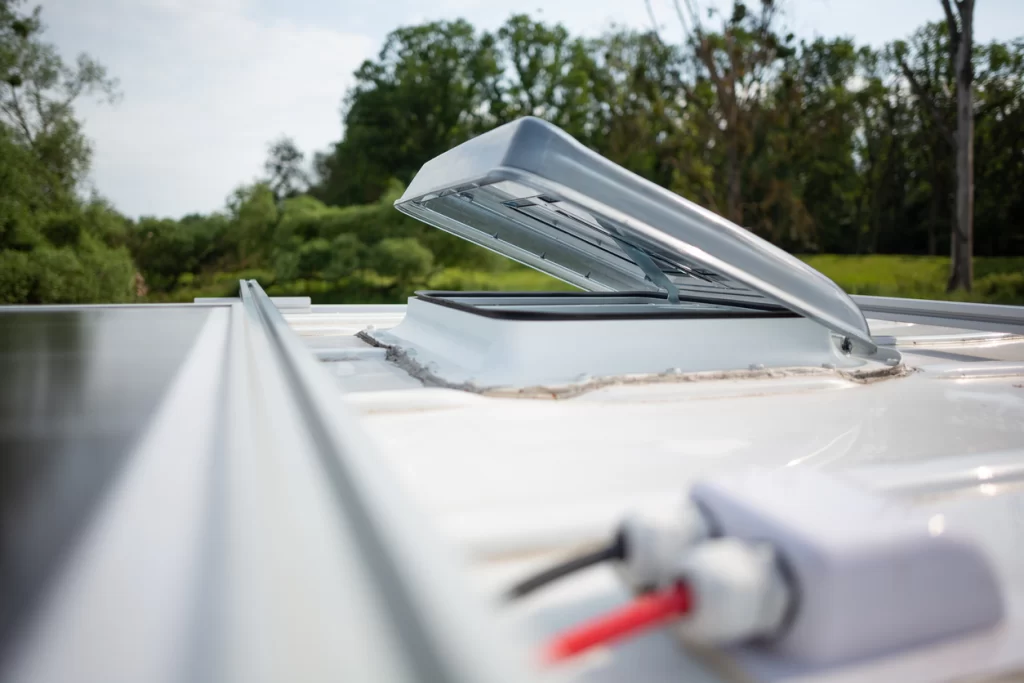Table of Contents
- Understanding RV Roof Types
- Identifying Roof Damage
- Basic RV Roof Repair Techniques
- DIY vs Professional Repairs
- Maintaining Your RV Roof
- Cost of RV Roof Repairs
- Common Roof Repair Products
- FAQs About RV Roof Repairs
Understanding RV Roof Types
In summary, choosing the right repair supplies is contingent upon the roof type. For instance, EPDM roofs typically require special self-leveling sealants while TPO roofs might need specific adhesives designed for the material.
This knowledge assists in avoiding potential damage that could arise from using incompatible products.
- Identifying your RV roof type (EPDM or TPO) is essential for proper maintenance and repairs.
- EPDM roofs are highly durable and UV resistant, making them suitable for various weather.
- TPO roofs are often more cost-effective and easier to install.
Identifying Roof Damage
To assist you further, here are some tips for effective visual roof inspections:
Visual Inspection Tips
- Use binoculars for a detailed overview of hard-to-reach areas.
- Check for any debris or leaves that may trap moisture.
- Perform your inspection after significant weather events—heavy rain or hail can reveal new problems.
Understanding the effects of water damage is vital for RV owners. If left unchecked, leaks can lead to mold growth, structural damage, and expensive repairs.
Regularly monitoring and addressing these issues ensures your RV remains watertight and structurally sound.
- Routine inspections are vital for early detection of roof damage.
- Signs of damage include cracks, blisters, soft spots, and water stains.
- Check seals regularly around features like vents and AC units to prevent future leaks.
Basic RV Roof Repair Techniques
Patching RV Roofs
Applying Sealants
Important: Always refer to manufacturer guidelines and recommendations to ensure the correct application process is followed to avoid any future damage.
Safety Precautions During Repair
- Basic repairs like patching and applying sealants can be done by RV owners.
- Thoroughly clean the area before applying patches or sealants.
- Follow safety precautions to prevent accidents when working on the roof.
DIY vs Professional Repairs
When to DIY
Benefits of Professional Repair
Here’s a comparative cost analysis that helps underscore the financial aspects of repairs:
It’s clear that while DIY tasks can be economical for simple fixes, opting for professional services for more complex issues can save you from costly mistakes down the road. Always weigh your capabilities against the potential risks before deciding the approach.
- Minor repairs are feasible for DIY enthusiasts, while major repairs often require professional help.
- Professional repairs often come with warranties and expert craftsmanship.
- Weigh the costs and benefits of DIY versus professional repairs seriously.
Maintaining Your RV Roof
Cleaning Techniques
Protective Coatings
Inspection Schedules
- Regular cleaning prevents moisture and debris buildup on the RV roof.
- Protective coatings offer an additional layer of defense against UV and water damage.
- Establishing an inspection schedule is crucial for early damage detection.
Cost of RV Roof Repairs
Estimating Repair Costs
Cost Comparison: DIY vs. Professional
Regular preventative maintenance tends to be more cost-effective than waiting for severe leaks and structural issues to arise. Most experts agree that roof maintenance is an investment that ultimately saves money.
- Understanding costs helps RV owners budget effectively for repairs.
- DIY repairs are commonly less expensive compared to professional services.
- Preventative maintenance can save on significant repair expenses in the long run.
Common Roof Repair Products
Top Recommended Repair Products
Using Quality Materials
Investing in quality repair materials can drastically enhance your RV roof’s resilience against harsh weather, extending its service life. Keep in mind the importance of adhering closely to product instructions to ensure effective applications.
- Using trusted products aids in achieving waterproof and long-lasting repairs.
- Compatibility with your roof type is crucial when selecting repair materials.
- Quality investments in maintenance materials pay off in the long run.

